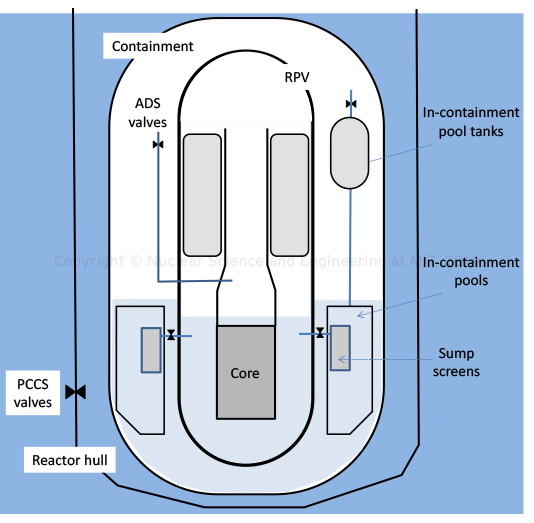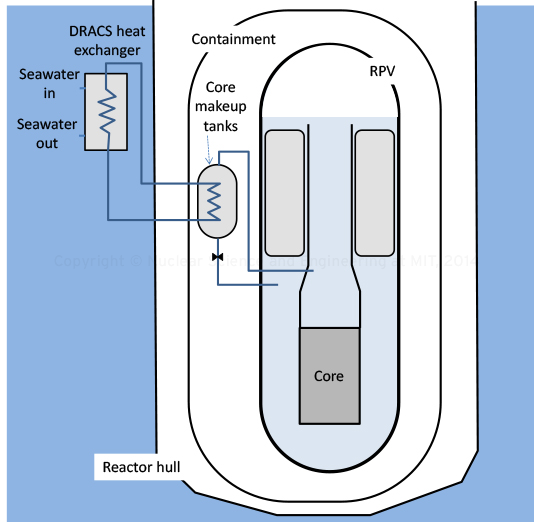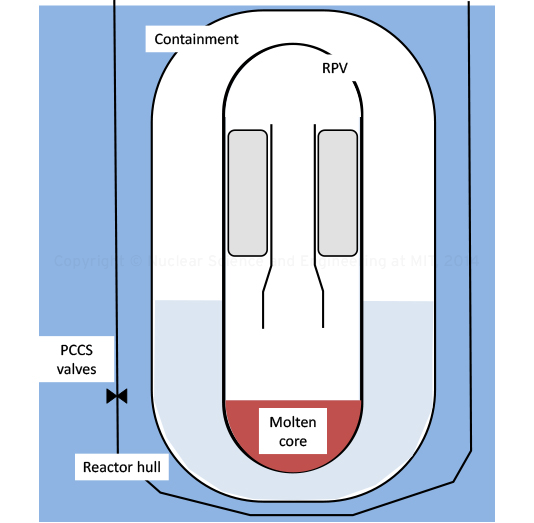The offshore floating plant safety case is based on a four-pronged strategy: (1) minimize accident precursors (especially external events) by design, (2) use passive safety systems to respond to design-basis accidents and minimize the likelihood of severe (beyond-design-basis) accidents, (3) adopt a robust containment design to cope with these accidents, and (4) minimize on-land consequences of these accidents. While (1), (2) and (3) are common to many modern reactor designs, (4) is a unique feature of the offshore plant.
External Events
Since the offshore plant is floating, seismic loads from the ocean floor do not transfer to the plant structures; consequently, earthquakes are completely eliminated as a safety concern. Moreover, the plant is sited a few miles off the coast, where tsunami waves are much smaller and their period so long (i.e. order of minutes to hours) that, upon passage of a tsunami wave, the plant simply rides the wave without danger of being submerged. Therefore, tsunamis are also eliminated as accident precursors.
Engineered Safety Systems
Following the NRC terminology, licensing basis events can be categorized according to their expected frequency as Abnormal Operational Events (AOE, frequency >1x10-2 per plant-year), Design Basis Events (DBE, frequency >1x10-4 per plant-year), and Beyond-Design Basis Events (BDBE, frequency >5x10-7 per plant-year).
For AOEs, the offshore floating plant relies on the traditional systems that have been developed for Light Water Reactor (LWRs), i.e., control rods and standby liquid boron control system (for redundant and diverse emergency shutdown), and shutdown cooling through the auxiliary feedwater system.
For DBEs, the plant relies on the passive safety systems developed for terrestrial SMRs, but modified to take advantage of the underwater nuclear island design. Therefore, for decay heat removal given a DBE at operational pressures, there is a dedicated Direct Reactor Auxiliary Cooling System (DRACS) that is based on natural circulation from the Reactor Pressure Vessel (RPV) to an intermediate closed water loop and ultimately to seawater (see figure below). This system can function indefinitely without AC power or refilling of any tanks.
Decay heat removal for DBEs without RPV depressurization
For a DBE that causes depressurization of the primary system (e.g., a Loss-Of-Coolant Accident or LOCA), short-term core cooling is achieved by gravity-driven injection, from core-makeup tanks or accumulators. For long-term accident response, the floating plant adopts a Passive Containment Cooling System (PCCS) similar to the Westinghouse SMR, in which the normal design of near-vacuum conditions allow for very efficient condensation heat transfer at the inner surface of the containment shell, conduction through the steel shell, and then convective heat transfer in the gap between the containment shell and the hull, flooded with seawater upon detection of a major accident (see figure below). The containment water inventory circulates back to the reactor core to keep it submerged under all postulated conditions. Note that no seawater is ever present within the containment or the RPV. This PCCS also operates indefinitely without AC power or refilling of tanks. As such, the floating plant design has eliminated the loss of ultimate heat sink accident altogether.
The combined elimination of major accident precursors such as earthquakes and tsunamis, and a major accident such as the loss of ultimate heat sink accident should make the probability of core damage for the floating plant significantly lower than even the safest terrestrial plants. However, the principle of defense in depth mandates that the consequences of core damage be explicitly addressed in the design, as explained next.
Core and containment cooling in a post-LOCA situation
Severe Accidents
For postulated BDBEs, the fuel rods severely degrade resulting in a substantial amount of hydrogen generation and molten material (or corium). In this case, the objective is to eliminate any combustible gas hazards and allow the degraded core materials to attain a long-term coolable state. The floating plant strategy is to retain the corium inside the RPV, which is achieved by flooding the RPV cavity with containment water. This in-vessel retention strategy ensures that the thermo-mechanical loads on the containment remain low; moreover, given that the containment is initially under near-vacuum conditions, it would not be possible for hydrogen combustion to occur in a steam-inerted environment. As such, we expect to effectively eliminate the need for containment venting even in case of severe accidents.
In-vessel retention and cooling of corium during BDBEs
Finally, should containment venting become necessary for whatever unforeseen reasons, venting would be done directly underwater, which would reduce the radiation levels in the atmosphere and on land by orders of magnitude. As a result, it is likely the need for an evacuation zone could be eliminated, which would constitute a major advance in the social acceptability of nuclear power. Analysis of dispersion of radionuclides in the ocean and their effects on marine life is ongoing.



3 Comments
Anonymous
The thing which is unclear is the problems to be tackled. Perhaps creating a new section for the problems to be tackled might be good in giving a direction.
Anonymous
the hydrogen your get out of your overheated core, you get out of water dissociation. You either need to recombine this over a catalist or you need to vent this. Else you´re regulators are not going to pass your design.
Anonymous
..and you want to vent this over a set of gas washer and filters, radiation monitoring you can do over a set of detectors (buoy net?) at a conveniently spaced net.